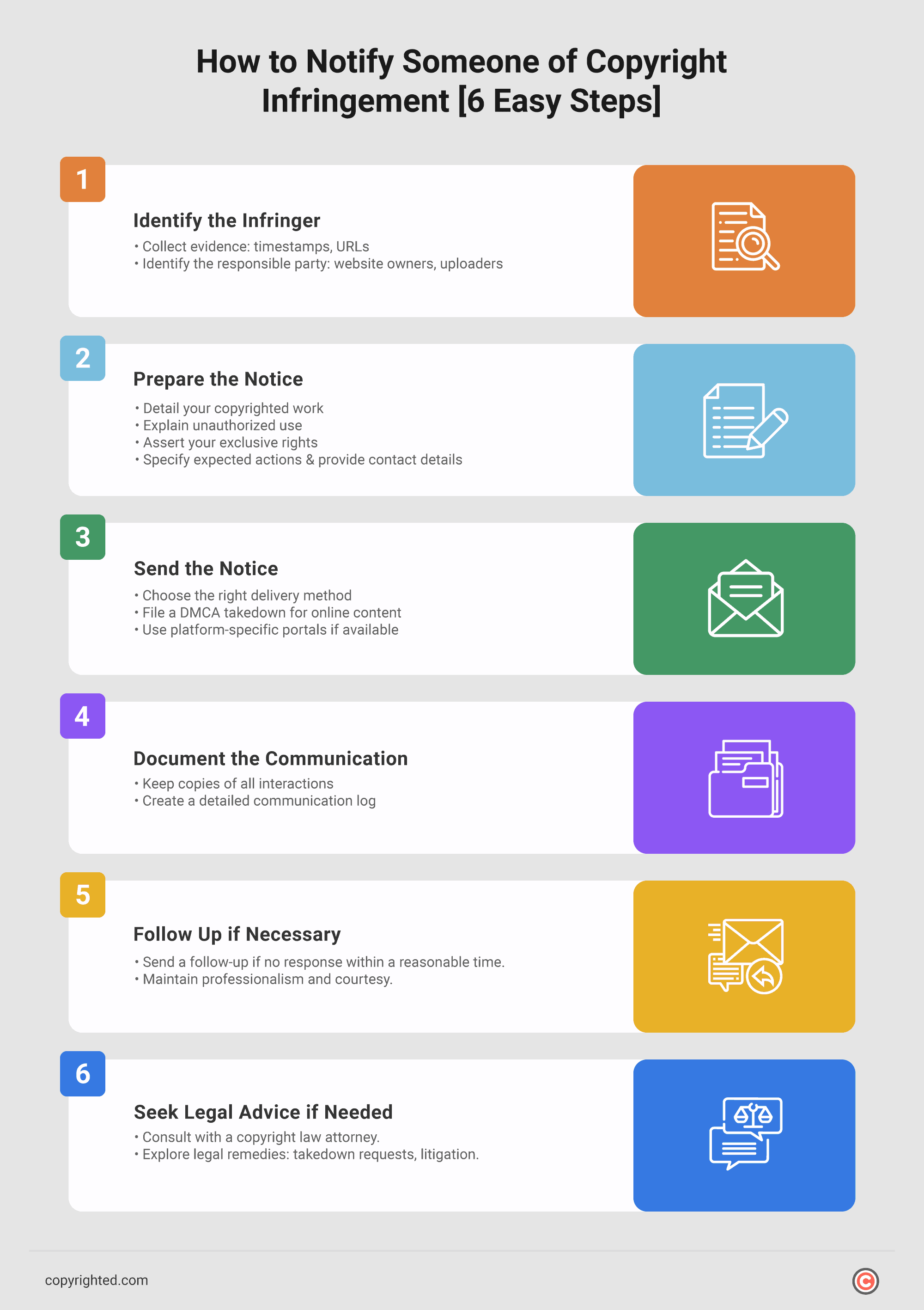In today’s digital age, copyright infringement poses a significant threat to creators, artists, and businesses alike. Discovering your work being unlawfully used can be daunting, but effectively addressing this challenge is essential.
The initial step in addressing copyright infringement is notifying the relevant parties, whether it’s the infringing individual or the platform hosting the unauthorized content.
If you’re unsure about the process, this guide will help you create an effective copyright notification and deliver it using the appropriate methods based on your circumstances.
By asserting your rights as the copyright holder and promptly addressing the infringement, you can mitigate potential damages and protect your intellectual property.
- Copyright infringement notices can be effective in prompting action from infringing parties and resolving disputes.
- It’s important to choose the appropriate way to send your infringement notice depending on the circumstances.
- Several platforms have their own portals for reporting copyright infringement, such as Facebook, Shopify, and Instagram.
Table of Contents
How to Notify Someone of Copyright Infringement?
If you’ve discovered that your copyrighted material has been used without your permission, you must take action immediately. Notifying the infringer is the first step in protecting your rights and potentially resolving the issue.
Understanding how to report copyright infringement properly can make this process more effective and ensure that your concerns are addressed in a timely manner.
Below is a step-by-step guide on how to effectively send a copyright infringement notice.

1. Identify the Infringer
To start, it’s essential to collect compelling evidence about the infringement, including timestamps, URLs, and relevant documentation illustrating the unauthorized use of the copyrighted work. Additionally, reviewing the usage of your work can reveal instances of reproduction, distribution, or adaptation that violate your exclusive rights as the copyright holder.
In tandem with gathering evidence, efforts should be made to identify the party responsible for the infringement. This may involve tracing the source of the infringing content, such as website owners, uploaders, or distributors.
2. Prepare the Notice
A well-prepared notice lays the foundation for addressing the infringement effectively. Preparation involves crafting a clear and concise letter or email that outlines the infringement.
Be sure to include specific details about your copyrighted work, such as its title and authorship, to establish ownership. Clearly explain how the work is being used without authorization to emphasize the extent of the infringement.
Additionally, assert your rights as the copyright owner in the notice. Clearly state your exclusive rights, such as reproduction and distribution, to underscore the seriousness of the violation.
Specify the actions you expect the infringer to take, such as removing the infringing content and providing compensation for damages. In certain cases, issuing a copyright infringement cease and desist letter can further reinforce your demands and highlight the potential legal consequences of non-compliance.
This sets a clear expectation for resolving the infringement and protecting your intellectual property rights.
Don’t forget to provide your contact details within the notification, including your name, address, email, and phone number. This makes it easier for the infringer to reach out to you to discuss the matter further or to initiate resolution proceedings.
3. Send the Notice
It’s important to choose the appropriate method of delivery based on the circumstances. You need to ensure the notice reaches the right recipient, whether it’s an individual, organization, or service provider, which might entail using different methods like email, postal mail, or specific online platforms.
In cases where the infringement involves online content hosted by a service provider, such as a website or online platform, you can file a DMCA takedown notice. This formal request is directed to the service provider and requires them to promptly remove or disable access to the infringing material upon receipt of the notice.
Several platforms have their own portals for reporting copyright infringement, such as Facebook, Shopify, and Instagram.
By leveraging the takedown process of the Digital Millennium Copyright Act, you can successfully address online infringement and protect your intellectual property rights on digital platforms.
4. Document the Communication
Sending the notice marks the end of the task, yet it’s crucial to preserve copies of all interactions with the infringing party, including duplicates of the sent notification and any responses received.
By doing so, you establish a comprehensive paper trail that can serve as evidence in the event of further legal action or dispute resolution.
Creating a detailed log of the communication process, including dates, times, and specific actions taken, is advisable. This documentation serves as a valuable resource for tracking the progress of the notification.
5. Follow Up if Necessary
If you don’t receive a response within a reasonable timeframe, consider sending a follow-up communication to the infringer. Persistence may be necessary in seeking resolution, but don’t forget to maintain a professional and courteous demeanor in all interactions.
6. Seek Legal Advice if Needed
If the infringement persists or escalates, consider consulting with a qualified attorney specializing in copyright law. They can provide further guidance and assistance, including exploring available legal remedies such as filing a formal takedown request or pursuing litigation if necessary.
What to Include in a Copyright Infringement Notification
A copyright infringement notification is vital for asserting your rights and seeking corrective actions. Sending a compelling notification is key to potentially addressing the infringement immediately and amicably.
Below are essential elements to consider when drafting a copyright infringement notification.
- Identification of the Copyrighted Work: Clearly specify the copyrighted work that has been infringed upon. Include details such as the title, author/creator, publication date, and any registration or identification numbers associated with the copyright.
- Description of the Infringement: Provide a detailed description of how the copyrighted work has been used without authorization. Include specific instances of infringement, such as unauthorized copying, distribution, display, or adaptation of the work.
- Evidence of Infringement: Present evidence to substantiate your claim of copyright infringement. This may include screenshots, URLs, timestamps, or other documentation demonstrating the unauthorized use of your copyrighted work.
- Contact Information: Include your contact details within the notification. Provide your name, address, email address, and phone number to facilitate communication with the infringing party and any relevant legal authorities.
- Statement of Ownership: You have to assert your ownership of the copyrighted work and your rights as the copyright holder. State that you have not granted permission for the unauthorized use of your work and that such use constitutes infringement.
- Request for Remedial Action: State the actions you expect the infringing party to take to remedy the infringement. This may include ceasing the unauthorized use of the copyrighted work, removing infringing content, and providing compensation for damages incurred.
- Deadline for Response: Specify a deadline for the infringing party to respond to the notification and take remedial action. This deadline should be reasonable but clearly communicated to convey the urgency of the matter.
- Legal Disclaimer: Include a legal disclaimer stating that the information provided in the notification is accurate and truthful to the best of your knowledge. Also, mention the potential legal consequences of continued infringement.
- Signature: Sign the copyright infringement notification to authenticate the document. Your signature adds credibility and authority to the notification.
Frequently Asked Questions
What happens after you submit a copyright infringement notification?
After submitting a copyright infringement notification, the recipient is typically required to review the claim and take appropriate actions, such as removing the infringing content or providing a counter-notification. Further steps may involve negotiations, legal proceedings, or compliance with takedown requests.
How long does it typically take to resolve a copyright infringement claim?
The time taken to resolve a copyright infringement claim varies depending on various factors, including the complexity of the case, the responsiveness of the parties involved, and legal processes. In some cases, resolution can occur within days or weeks, while others may take months or even longer to reach a satisfactory outcome.
Is it necessary to have a registered copyright to notify of infringement?
No, it is not necessary to have a registered copyright to notify of infringement. While registration provides additional benefits, such as statutory damages and evidentiary advantages in court, it is not a prerequisite for asserting your rights and notifying of infringement.
How should evidence of infringement be collected and preserved?
Evidence of infringement should be collected and preserved meticulously to support your copyright infringement claim. This may involve capturing screenshots, saving URLs, timestamps, or any other relevant documentation that demonstrates the unauthorized use of your copyrighted work.
Are copyright infringement notices effective?
Copyright infringement notices can be effective in prompting action from infringing parties and resolving disputes. However, their effectiveness may vary depending on factors such as the responsiveness of the recipient, the strength of the evidence provided, and the legal mechanisms available for enforcement.


